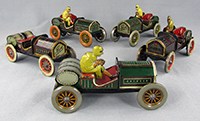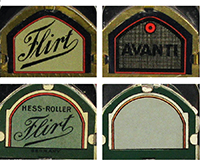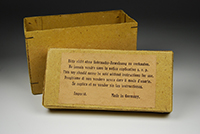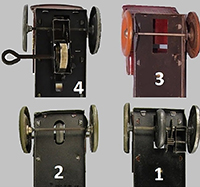 |
||||
|---|---|---|---|---|
 |
Hessmobil 1020 wind-up with steerable front wheels. The great majority of all Hessmobils had cranked flywheel power for propulsion. I have seen a few examples with wind-ups and this is one of them. For whatever reason, perhaps materials shortages, Hess chose to power a few with a clockwork mechanism. This example is an early production model denoted by the rounded trunk and spoked wheels, circa1920's. Another ususual feature of this auto is the color - orange. All other model 1020 autos were a maroon color or later production models with flat trunk were a bright red. Early models were given a race type driver, with later models given a chauffeur type driver. | |||
 |
Hess “Flirt” grouping, with either simple flywheel drive or friction flywheel mechanism. Car: L 13 cm, W 5.4 cm, H 7.6 cm with driver. All circa 1900 - 1910 A grouping of Hess “Flirt” autos, all marked differently. The name “Hess Roller” on toys was not used until 1912 to differentiate between simple flywheel drive and the new flywheel friction mechanism. |
|||
  |
Different markings of Hess “Flirt” autos Various markings on the radiator and rear of the vehicles observed over the life of this little auto. “Flirt” was used on autos before 1912 which used a simple flywheel drive. “Hess Roller” and “Flirt” was used from 1912 on to denote the new and improved geared flywheel friction mechanism. The “Avanti” marking on the front radiator was used on the “Peking to Paris” version of this vehicle commemorating the rally of 1908. There may be other different marked vehicles as there was much variation in all that Hess produced. |
|||
 |
Hess Roller “Flirt” box Shown is a box for the Hess Roller “Flirt” auto. A very plain chipboard box with a simple message saying “This toy should never be sold without instructions for use” in several languages. |
|||
 |
Hess Flirt Propulsion Mechanisms The Hess Flirt roadster and touring cars utilized several different methods of propulsion during their production life. Shown in the photos are: 1 – Post 1912 Hess “Roller” flywheel friction mechanism; 2 – Pre 1912 simple flywheel on axle; 3 – Push power only with no mechanism; 4 – clockwork mechanism with permanent key. Number 3 and 4 were probably produced during or shortly after WW1 with a shortage of materials contributing to the change from flywheel power. Number 4 has no markings to indicate Hess, Flirt, or made in Germany, so was probably not meant for export during this time. Also, wheels on number 3 and 4 were painted a single solid color (gray or orange) without detail such as spokes.
|
|||

